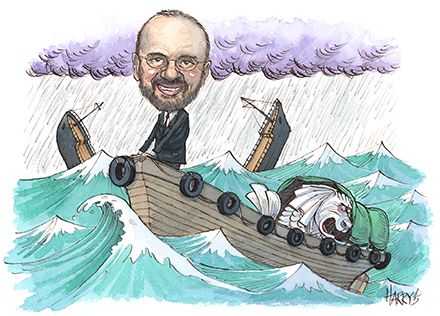In a year when many of the region’s homegrown banks retreated from investment banking or found themselves under regulatory scrutiny, one bank sailed around the storm and continued to expand. For its measured approach and sustainable expansion, DBS is IFR’s Asian Bank of the Year.
DBS marked 2015 with more record profits, a still-dominant position in Singapore and continued expansion beyond its home market. It played a bigger role in connecting clients across Asia and added to its suite of capital markets products in a challenging year for its home market.
While a volatile China cast a shadow over South-East Asia, DBS stuck with its clients and resisted the urge to chase short-term business. Its measured approach to investment banking has seen it avoid many of the pitfalls that hurt its more aggressive peers, and stands it in good stead for a stable future.
“I have no desire to be a bulge bracket. We are customer-centric, not a team of pizzazz bankers,” said DBS chief executive Piyush Gupta. “We cater to the right size for the opportunity as we see it, and it’s very scalable.”
Singapore’s biggest bank has come a long way since Gupta took over in 2009. It has doubled full-year profits to S$4.05bn, the result of 25 consecutive quarters of year-on-year growth at a time when interest rates have remained stubbornly low – traditionally a drag on earnings for any big deposit-taking lender.
In that same period it has expanded its international client list from a low base and now banks close to 700 Chinese companies, 250 multinationals and covers around 1,000 institutional investors.
Third-quarter 2015 results surprised on the upside with a 6% year-on-year increase in net profit, thanks to a higher net interest margin and lower ratio of impaired loans. While investment banking income in the quarter dropped 65% from the previous year on Singapore’s ECM slump, loan-related fees were up 28%, illustrating the benefits of DBS’s full-service model and its growing regional network.
Thomson Reuters/Freeman Consulting fee data show DBS grew overall investment banking fee income 6% during IFR’s review period despite the dearth of ECM business. Fees from the loans business expanded close to 40% versus the previous 12 months, and it bucked a squeeze in regional DCM revenues to post another positive year.
Gupta is happy to be patient in search of steady, sustainable growth. He has time on his side, with a solid loan book and healthy capital ratios that allow the bank to stick by its clients through industry cycles and manage short-term volatility in individual asset classes. There is no sense that the bank is rushing the expansion of its institutional business, or that it is taking on unmanageable risks to do so.
“Singapore has shown this before, and China’s showing it now. You can’t fight the cycle,” said Gupta. “But if you can ride it out, the payback is quick.”
Troubles in the commodity sector and uncertainty over global interest rates weighed on local financings in 2015. Keppel DC REIT’s S$513m IPO in December 2014 was the only major new listing completed during IFR’s review period, as investors turned cautious on the income-based format.
Still, DBS was involved in over 70% of all equity offerings during the year in Singapore, including a S$525m underwritten follow-on offering for Keppel Infrastructure Trust that was in some ways a re-IPO following its merger with CitySpring.
Bases covered
It enjoyed a better year in debt financing, where investments beyond Singapore translated into opportunities to connect borrowers and investors across Asia.
It brought ICBC to the Singapore market for offshore renminbi financing, satisfying the city’s growing demand for investments in the Chinese currency, and helped bring ANZ to Singapore for Tier 2 capital.
DBS continued to make inroads in Greater China, with bookrunner roles on Dim Sum bond issues for the likes of Bohai General Capital and China Minmetals. It deepened its presence in the global bond markets with dollar deals for Huawei, China Cinda Asset Management and others, and handled more complicated perpetual offerings for SMC Global Power and Central Plaza Development.
“Our key client is the new Asian MNC,” said Gupta. “There we can differentiate ourselves through our local coverage and deep understanding of local issues, and can really be a full service provider.”
The bank’s first covered bond, a US$1bn three-year deal in late July, was another example of DBS taking the time to get it right. More than three years after the regulator wrote its first draft of covered bond rules, the city’s inaugural deal set the standard for the rest of Asia with a solid structure and top credit rating.
DBS also invested time and technology in providing comprehensive data on the underlying cover pool, underlining its commitment to high standards of transparency and accountability, and laying the foundations for regular issuance in the future.
Syndicated finance performed well in a sluggish year for Asian lending, with slowing economic growth and mounting credit concerns pegging back overall volumes.
DBS sealed a number of lucrative deals, such as the refinancing of STATS ChipPAC that enabled Jiangsu Changjiang Electronics Technology’s US$1.8bn cross-border acquisition, combining bridge loans, term loans and a global bond.
The bank was also instrumental in the restructuring of several Keppel group companies, arranging loans for the privatisation of Keppel Land, the merger of Keppel Infrastructure Trust with CitySpring and Keppel Merlimau Cogen, and the establishment of Keppel DC REIT.
It stuck by global and Asian commodity firms despite ongoing headwinds plaguing the commodities sector, and distributed its risk well, leading popular syndications in Singapore for the likes of Trafigura and Gunvor.
It turned more cautious on China and stressed sectors such as oil services, but brought new investors into deals in Taiwan, Indonesia and India, underlining its ability to focus resources despite a relatively low cost base.
“When it comes to connectivity, there is a goldilocks size,” said Gupta. “You have to be big enough to give clients what they need, but a nimble management is also important.”
Over the past five years, DBS has posted a 9% compound annual growth rate for overall revenues, growing its institutional business at a 13% compound rate.
Staff turnover is low and capital ratios are sound. Markets may not have fallen in Singapore’s favour in 2015, but Gupta can be confident that the DBS platform presents a more stable alternative to the traditional approach to investment banking favoured by its global rivals.
“Asia’s wallet is not the same as the US wallet. The pizzazz approach doesn’t work here,” said Gupta. “The real Asian opportunity is within Asia. It’s an opportunity to be the intermediary. That’s why we’ve doubled our investor coverage in the past three years.”
DBS is building in China and India as it seeks deeper connections across Asia, but it is prepared to play the long game. As its network grows, Gupta is confident that opportunities to connect issuers and investors will present themselves.
“The P&L is in good shape, and it’s a sustainable model.”
To see the digital version of this report, please click here.



